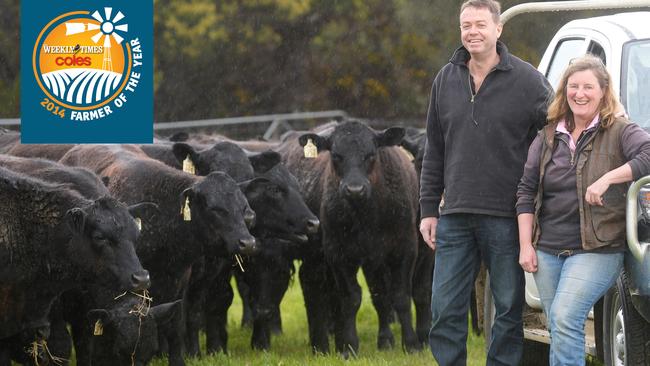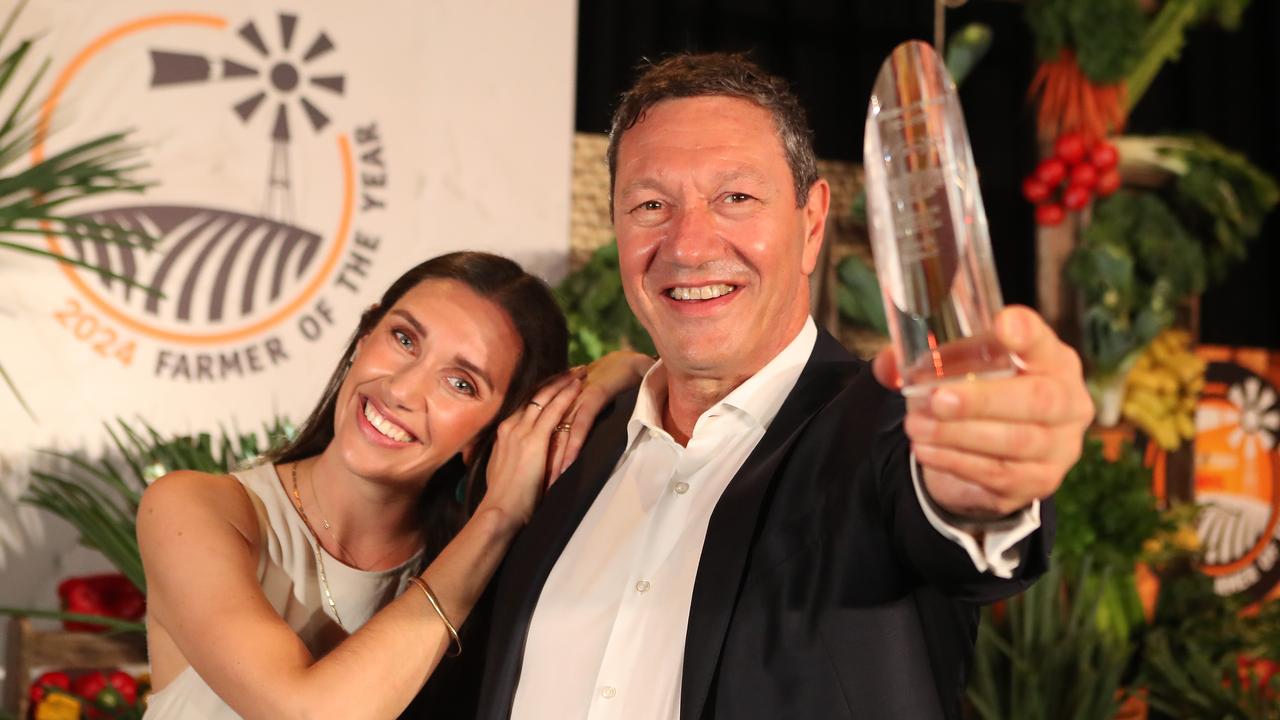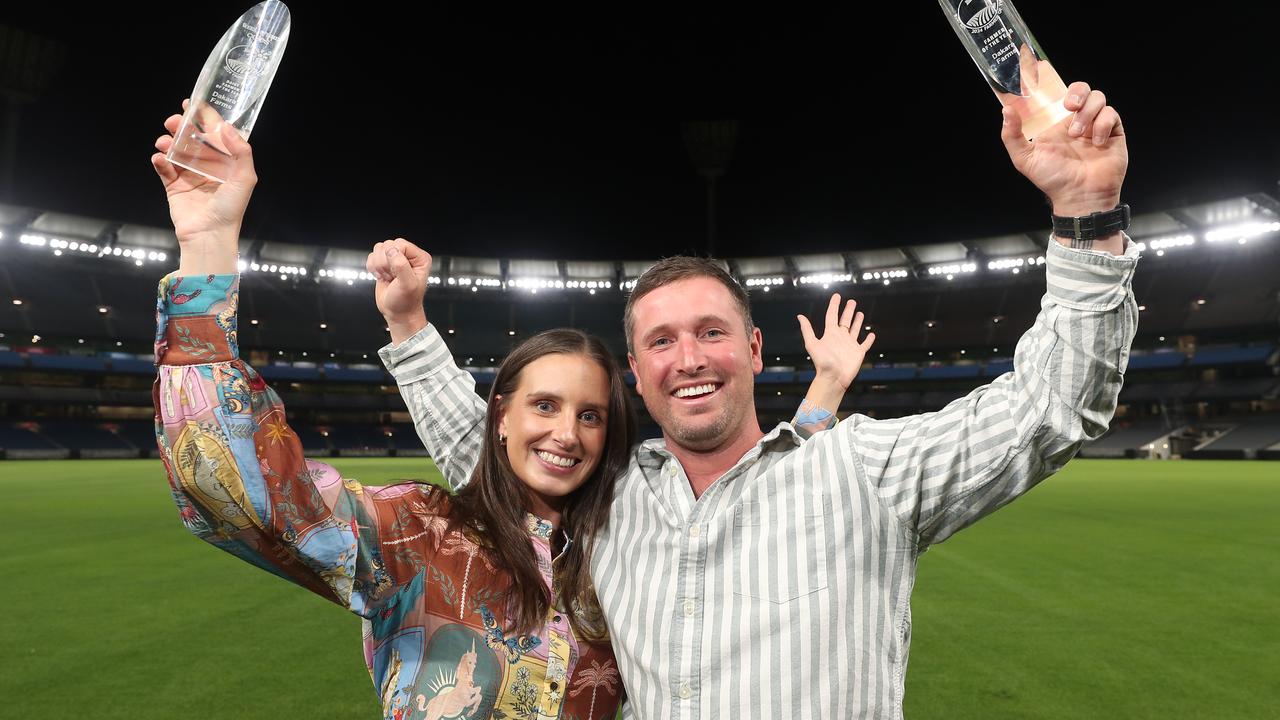Genes a top fit at Knewleave Partnership on the Bellarine Peninsula
THE figures well and truly add up for this beef operation on the picturesque Bellarine Peninsula.

WHEN it comes to boosting the genetics of her cattle herd, Fiona Conroy draws on experience from within her own bloodlines.
“My father (David) was very keen on performance recording and his attitude was if you couldn’t measure it, you didn’t know whether you were improving,” she says.
It’s a mantra Fiona — a journalist and former Weekly Times livestock editor — and her husband, agronomist and consultant Cam Nicholson, follow today on their Knewleave Partnership farm near St Leonards, on Victoria’s picturesque Bellarine Peninsula.
Here, in a 550mm rainfall area, they push production — turning out up to 350kg of beef per hectare and boasting a higher-than-normal stocking rate of 23-24 dry sheep equivalents — while keeping more than a close eye on the environment.
Nine per cent of the 285ha farm is fenced off to trees and watercourses, providing an effective grazing area of 258ha.
Here the couple run 220 Angus cows, producing steers for the lucrative long-fed Japanese market, alongside an 18-micron self-replacing Merino ewe flock (older ewes are joined to White Suffolk rams to produce first-cross lambs). The business split is about 76 per cent beef to 24 per cent sheep, up from 50:50 about 15 years ago.
The farm is a low labour input operation, which allows the couple to juggle family and work commitments (Cam works off farm full-time and Fiona three days a week and they live in nearby Queenscliff).
This means there has been the need for considerable capital investment in all-weather laneways, single-person operation yards and good water facilities.
The operation is unique in that Fiona and Cam have separated the management of the farm from the land ownership. The land is leased from various people “including ourselves” on the premise “that we can move the business if people wanted to sell various blocks”.
On the beef front, Fiona’s family first used genetics from the Te Mania Angus stud at Mortlake (and formerly of Colac) in 1989. Ten years later they joined the Team Te Mania program, whereby bulls are leased from the stud and herds participate in comprehensive data recording, and in 2003 became a Te Mania progeny test herd, which requires intensive documentation similar to a stud herd.
Depending on the season, Fiona and Cam run 190-220 breeding cows. The main game is turning off steers to the long-fed feedlot market weighing about 440kg at 15 months of age.
The herd is recorded on the commercial Breedplan register with Angus Australia.
All cows are single-sire mated in mobs of 50-60 for six weeks for a spring calving. Previously, artificial insemination was used on the cows but in recent years it has been restricted to heifers only for ease of management during the synchronisation program.
Bulls, which are generally retained for three years, go in with the cows in November and come out between Christmas and New Year.
“We do have issues because we farm both sides of the road (a major thoroughfare from Geelong to St Leonards), one of the challenges is when we’ve got to take bulls out tends to be when people are going to caravan parks down the road,” Fiona said.
All 50-70 heifers are artificially inseminated for two rounds, with the help of Nationwide Artificial Breeders at Noorat. Fiona said being a progeny-test herd gave them the opportunity to use a range of semen from Te Mania’s up and coming young sires, as well as semen from proven sires.
All females are ultrasound pregnancy tested six weeks after the bulls come out. Any empty mature cow is culled while heifers that don’t get into calf after two rounds of AI are rejoined for an autumn calving and sold with calves through the Team Te Mania online AuctionsPlus sale (last year Fiona and Cam topped the sale).
Calving runs for five to six weeks from the start of August. Within 24 hours of being born, each calf is tagged, weighed, marked if by a bull and matched to its mother. An electronic National Livestock Identification System tag is then attached and scanned with a wand feeding information back to a laptop computer.
Any female that has an assisted calving or fails to rear a calf is culled.
Calves are yard weaned between January and March with the timing dependent on the season and mother’s condition. At weaning, all calves have their 200-day weight recorded, are drenched, vaccinated with 7-in-1, fed lucerne hay and exposed to horses and dogs.
They are then split into steer and heifer mobs and run under commercial conditions. The calves return to the yards at 400 days, where their weight is recorded for Breedplan purposes and, to strengthen Te Mania estimated breeding values, ultrasound scanning of eye muscle area, P8 fat, rib fat and intramuscular fat is carried out.
The couple put “enormous selection pressure” on fertility. “When we cull cattle, we don’t look at who they are by or what their breeding is. We treat them all as commercial cows,” Fiona said.
Cattle are fed during autumn and, if required, winter. During the millennium drought, pellets were fed extensively as the herd’s MN3 Johne’s disease-free status meant off-farm agistment was not an option.
In an attempt to maximise returns, surplus females are usually sold as heifers rather than to abattoirs. All females are turned over by seven years “so then they’ve still got a commercial value to someone who might want to buy them with calves or pregnancy tested in calf”. “It also allows us to put greater genetic turnover in the herd by getting rid of older cows more regularly.”
Steers are sold through Chris Callow Cattle Service to Rangers Valley feedlot at Glen Innes in northern NSW where they are fed for the Japanese B3 long-fed market. Feedback from Rangers Valley points to Fiona and Cam’s cattle as being in the top 5 per cent in terms of profitability. Returns from the beef enterprise work out about $2-$2.10/kg which Cam said was “pretty handy when you think that includes cull cows etc”. Cost of production “in a more favourable year” is about 80-85c/kg.
Cam said about 25c/kg was spent on breeding, including leasing of bulls, artificial insemination and progeny test costs, 18c/kg on fodder (“in some of the tough years it can be anywhere up to 50c/kg”) and 27c/kg on pastures, of which 75-80 per cent is in the form of fertiliser and lime.
Given its location in a semi-urban and holiday area, the farm has high overhead costs — “rates is one of the things that is a real killer around here … and we insure ourselves to the hilt because we in an area so closely populated”.
About 40,000 trees have been planted in the past 15 years (direct seeding was introduced five years ago).
The farm generally receives a monthly rainfall of between 25mm and 65mm. It is not subject to frosts, which Cam said was a bonus as it led to good pasture growth during winter.
Cam said the combination of sheep and cattle was useful for pasture management and worm control. Getting the fundamentals right in terms of soils and pastures was important and there were “three broad areas you need to worry about”.
“First of all it’s getting the soil condition right, the second one is getting the grazing method right — how you actually go about eating that feed and how long you spell it for afterwards — and the third one is the species that you select,” he said.
In regards to soil fertility, phosphorus levels range from 15 to 18 parts per million while potassium rates vary between 150 and 200. Lime is applied every eight to 10 years while in recent years more chicken manure has been spread, at a rate of about 7.5 cubic metres per hectare.
Cam said some of the farm’s pastures were mostly perennial based with species-dominant paddocks: phalaris (Sirosa, Holdfast), perennial rye-grass (Victorian. Banquet II), tall fescue (Resolute) and Lucerne (Stamina GT). There is also a sub-clover base (Trikkala, Gosse and Riverina).
Some herbicides are used “mainly for manipulation” and “where we can use feed”.
“A lot of herbicide techniques actually take away food out of the system, so I tend to favour techniques that actually allow you to spray it, use grazing to eat that feed, and as well as getting control,” Cam said.
Grazing methods have ranged “anything from set stocking in the very early days” to “a very intensive grazing system where we subdivide the paddocks”. The couple consider spelling paddocks more important than grazing them.
“We’ve now got a system where we’ve got about four to six paddocks per mob, which is a compromise between how much pasture you can grow, how well it recovers and the extra grazing value you get from it,” he said.
Fiona said it was the use of artificial insemination and performance recording that stood the herd in good stead. “The genetics of the herd have made massive gains (through this),” she said.


